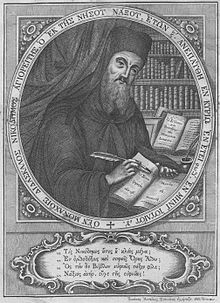
Back Никодим Светогорец Bulgarian Nikodemos der Hagiorite German Νικόδημος ο Αγιορείτης Greek Nicodemo el Hagiorita Spanish Nicodème l'Hagiorite French Nicodemo l'Agiorita Italian Никодим Святогорец Russian Nikodém Hagiorita SK Никодим Светогорац Serbian Никодим Святогорець Ukrainian
Nicodemus of the Holy Mountain | |
|---|---|
 Icon of Saint Nicodemus from the Great Synaxarion, published in Venice in 1819. | |
| Venerable, Hagiorite | |
| Born | 1749 Naxos |
| Died | July 14, 1809 (age 60) Mount Athos |
| Venerated in | Eastern Orthodox Church |
| Canonized | May 31, 1955 by the Patriarchate of Constantinople |
| Major shrine | Mount Athos; Church of the Naxian Saints, Naxos. |
| Feast | July 14; First Sunday of September (with the other Saints of Paros and Naxos) |
| Attributes | Long white beard, monastic garb, often writing on a scroll, or in a book. |
| Part of a series on the |
| Eastern Orthodox Church |
|---|
| Overview |
Nicodemus the Hagiorite or Nicodemus of the Holy Mountain (Greek: Ὅσιος Νικόδημος ὁ Ἁγιορείτης; 1749 – July 14, 1809) was a Greek ascetic monk, mystic, theologian, and philosopher, venerated as a saint in the Eastern Orthodox Church. His life's work was a revival of traditional Christian practices and patristic literature.
He wrote ascetic prayer literature and influenced the rediscovery of hesychasm, a method of contemplative prayer from the Byzantine period. He is most famous for his work with Macarius of Corinth on the anthology of monastic spiritual writings known as The Philokalia, as well as for his compilation of canons known as the Pedalion (or The Rudder) which he co-wrote with a hieromonk named Agapios Monachos. With Macarios of Corinth, Nicodemus was responsible for the compilation and publishing of The Evergetinos, thoroughly reviewing a vast collection of materials from a number of other collections of sayings of monastics and others, ranging from the well-known works of St. John Cassian and Palladius, to the anonymously produced Apophthegmata collections, but including materials also from hagiographies, menologia, and other, unspecified and now-lost sources. Assembling, collecting, and editing a number of manuscripts scattered among the libraries of Mount Athos, the Holy Mountain. Nicodemus was canonized by the Ecumenical Patriarch of Constantinople in 1955.